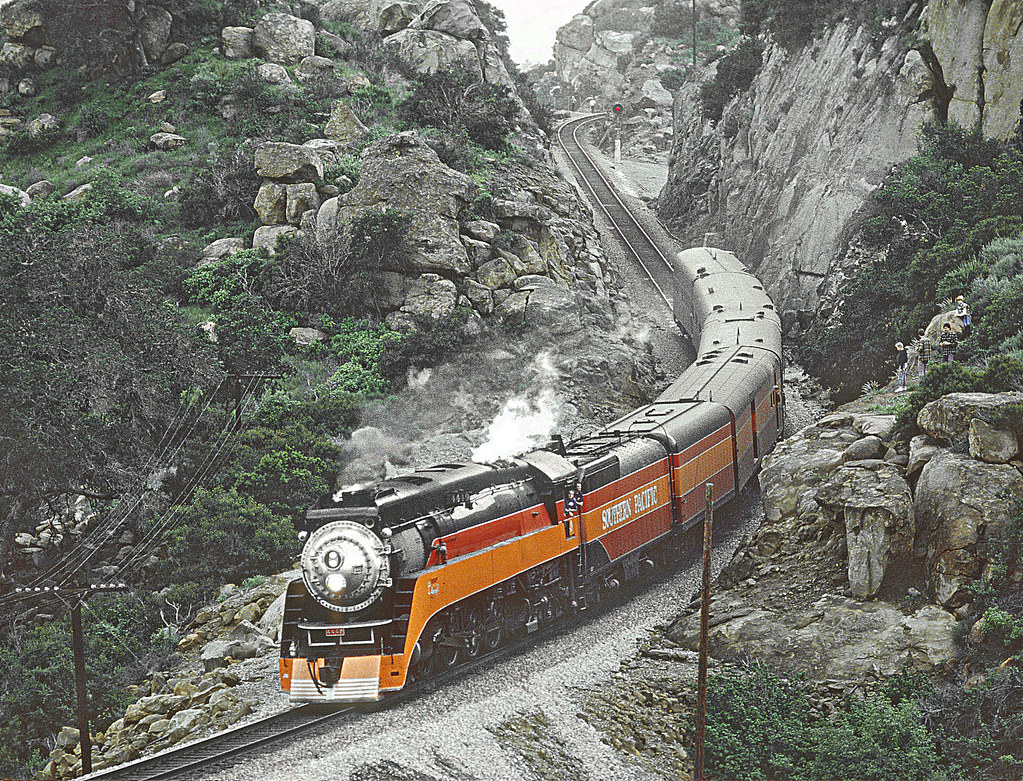
The Santa Susana Pass train observation spot is a scenic location nestled in the rugged terrain of Southern California. It offers breathtaking views of trains navigating the historic Southern Pacific Railroad tracks, surrounded by rocky landscapes and native vegetation, making it a favorite for rail enthusiasts and photographers.
Photos
Sign in to upload photos
No Photos Yet
Be the first to share photos of this location!
Santa Susana Pass – Chatsworth, California, USA | Train Spotting Location
Trainspotting Experience
Expect a multisensory rail encounter. Most visitors station themselves on the Rocky Peak Fire Road ridge or along the disused section of Old Santa Susana Stage Road, both offering elevated, legal vantage points roughly 200–300 feet above rail level. The line bends sharply on either side of the tunnel portals, so headlight beams appear well before the locomotives, giving ample prep time for cameras. Southbound trains climb at about 1.8 percent toward the 7,369-foot tunnel; helpers are uncommon but heavy freights often labor audibly, their dynamic brakes echoing against sandstone outcrops. Train speeds hover around 35–45 mph through the pass, slower than on the valley floors, allowing longer looks at consists that can exceed 6,000 feet. Horn use is minimal thanks to remote canyon surroundings, but the amplified engine rumble and flange squeal are unmistakable in the still air.
Landscape, Setting & Local Atmosphere
Santa Susana Pass straddles the Simi Hills at roughly 1,600 feet elevation, a transition zone between coastal sage scrub and oak-studded chaparral. Weather is typically clear and dry; from late fall through spring, cool marine layers can drift inland at dawn, adding atmospheric mist to photo backdrops. Summer days are hot but humidity is low, rewarding early morning or late afternoon stays. Massive sandstone boulders, rugged ridgelines, and distant views toward the San Fernando Valley create a dramatic, undeveloped setting. Aside from faint highway noise from SR-118 far below, the atmosphere feels remote, with red-tailed hawks circling overhead and the aroma of sage and buckwheat in the breeze.
Type & Frequency of Train Activity
Union Pacific’s Ventura Subdivision funnels a balanced mix of freight and passenger traffic through the pass. Railfans typically observe:
• Freight: 10–14 trains daily, a mix of manifest, unit grain, autorack, and intermodal blocks originating from the Port of Los Angeles/Long Beach or points northward. Distributed-power consists are common.
• Metrolink Ventura County Line: Approximately 24 commuter trains on weekdays (fewer on weekends) linking East Ventura with Los Angeles Union Station.
• Amtrak: Six daily Pacific Surfliner runs plus the northbound and southbound Coast Starlight.
Even during lighter weekend schedules, two to three movements per hour are not unusual during peak windows, making patience worthwhile.
Best Angles for Photos & What Railfans Enjoy Most
- South Portal Overlook: A short hike up Rocky Peak Fire Road yields a commanding view straight down to the tunnel mouth on the Chatsworth side—perfect for telephoto shots of head-on approaches framed by jagged rock walls. Late afternoon light side-illuminates westbound freights.
- North S-Curve Vista: From the Santa Susana Knolls side, a dirt turnout near the old stage road reveals the sinuous reverse curve just before trains dive into the tunnel. Morning sun lights up eastbound trains against green winter hills or golden summer grass.
- Ridge-Top Panoramas: Wider lenses capture trains snaking through the canyon floor with the Santa Monica Mountains silhouetted to the south. Sunset backlighting creates dramatic silhouettes of double-stack containers.
Low clutter, natural backdrops, and the chance to photograph both portals in a single session make this pass a standout among Southern California spots.
Historical or Cultural Relevance
Opened by the Southern Pacific in 1904, Tunnel 26 eliminated a tortuous, landslide-prone surface alignment and was California’s longest rail bore until the Tehachapi realignments. During World War II, troop trains routinely used the route, and the pass briefly hosted famed Daylight passenger consists. The nearby Chatsworth filming ranches exploited the dramatic rails-through-rocks scenery for 1930s westerns, and remnants of stagecoach ruts from the 1860s route can still be seen parallel to the tracks, offering a tangible timeline of regional transportation.
What Makes This Spot Different
Unlike flat valley locations where trains hurry past with little context, Santa Susana Pass pairs moderate train frequency with pronounced elevation change, tight curvature, and photogenic geology. The combination lets railfans witness locomotives working hard in a wild setting only 30 miles from downtown Los Angeles—no other accessible site in the region provides such continuous action within an undisturbed mountain backdrop. The ability to view both portals, plus the relative absence of fences or visual obstructions, further distinguishes the pass from more urban vantage points.
Localisation
Coordonnées :34.266307, -118.646628
Seasonal Information
For Santa Susana Pass, spring and fall offer mild weather and vibrant scenery, ideal for train watching. Summer can be hot, so bring sun protection. Winter provides unique views but check for weather-related delays. The area's rocky landscapes enhance the experience year-round.
Other Interesting Locations
Looking for more spots? Browse the complete list of train spotting locations.
Quick Information
Country
USA
Region / State / Province
California
City
Chatsworth
Spot Type
Scenic Overlook
Best Times
Best hours: Weekday mornings (7-9 AM) and evenings (5-7 PM) for peak train frequency; daylight hours for optimal visibility and photography.
